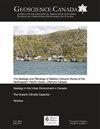遗产石9。廷德尔石,加拿大首个全球遗产石材资源:地质学、古生物学、鱼类学和建筑
IF 0.8
4区 地球科学
Q3 GEOSCIENCES, MULTIDISCIPLINARY
引用次数: 0
摘要
廷德尔石(Tyndall Stone)是一种独特的斑点状含化石白云质石灰岩,在加拿大,特别是大草原省,已经广泛使用了一个多世纪。它位于红河组43米厚的塞尔柯克段下部,长6-8米,属于晚奥陶世(卡第阶)。自1895年以来,它一直在温尼伯东北37公里的马尼托巴省加森独家开采,在过去的半个世纪里,开采一直由Gillis采石场有限公司单独进行。由于地下水风化,上层往往比灰色下层更黄。廷德尔石(Tyndall Stone)主要具有光滑或锯切的表面,已被广泛用于各种用途,包括带有分层和随机石磨的外部和内部覆层,以及窗户平开窗和门道。分面饰面和使用沿着风格石分割的各种颜色块的随机石磨分别在商业和住宅建筑中流行起来。廷德尔石也适合雕刻,用于柱子、纹章和雕塑。许多著名的建筑都是用廷德尔石建造的,包括萨斯喀彻温省和马尼托巴省的省级立法大楼、渥太华下议院中心区的内部、法院、土地所有权大楼、邮局和其他公共建筑,以及火车站、银行、教堂、百货公司、博物馆,办公楼和大学建筑。这些展览展示了各种建筑风格,从美术到装饰艺术,从城堡到野兽派。加拿大历史博物馆和加拿大人权博物馆是两座著名的表现主义建筑。塞尔柯克下段为块状,由生物扰动的生物碎屑粒砂岩至泥粒石组成,富含海百合小骨。它沉积在透光带内的低能量海洋环境中,位于现在的浅Williston盆地东侧,该盆地是当时覆盖劳伦斯大部分地区的广阔赤道陆表海的一部分。分散的薄生物碎屑粒状灰岩透镜体记录了偶发的高能事件。廷德尔石碑上有大量的化石,带有化石的石板越来越受欢迎。最常见的大型化石是隐窝类,其次是珊瑚、层孔虫海绵、鹦鹉螺类头足类和腹足类。宏观化石的相对丰度在地层上各不相同,这表明随着时间的推移,环境发生了微妙的变化。这种独特的斑点——行业中的“生物化学”——被认为是属于类海生物的白云岩化洞穴,长期以来被认为是可能由节肢动物形成的画廊网络。然而,详细地说,生物碎屑泥质沉积物经历了漫长的生物扰动历史,大洞穴大多是水平的回填特征,从来没有空过。它们可以被分配到Planolites。基质和填充其中的沉积物被几代较小的管状洞穴覆盖,由于其独特的叠层壁内衬,这些洞穴大多与古藻属有关。白云石在埋葬过程中取代了较大洞穴、较小洞穴和周围基质的内部,这就是为什么斑点的形状如此多变的原因。本文章由计算机程序翻译,如有差异,请以英文原文为准。
Heritage Stone 9. Tyndall Stone, Canada’s First Global Heritage Stone Resource: Geology, Paleontology, Ichnology and Architecture
Tyndall Stone is a distinctively mottled and strikingly fossiliferous dolomitic limestone that has been widely used for over a century in Canada, especially in the Prairie Provinces. It comprises 6–8 m within the lower part of the 43 m thick Selkirk Member of the Red River Formation, of Late Ordovician (Katian) age. It has been quarried exclusively at Garson, Manitoba, 37 km northeast of Winnipeg, since about 1895, and for the past half-century extraction has been carried out solely by Gillis Quarries Ltd. The upper beds tend to be more buff-coloured than the grey lower beds, as a result of groundwater weathering. Tyndall Stone, mostly with a smooth or sawn finish, has been put to a wide variety of uses, including exterior and interior cladding with coursed and random ashlar, and window casements and doorways. Split face finish and random ashlar using varicoloured blocks split along stylolites have become popular for commercial and residential buildings, respectively. Tyndall Stone lends itself to carving as well, being used in columns, coats of arms and sculptures. Many prominent buildings have been constructed using Tyndall Stone, including the provincial legislative buildings of Saskatchewan and Manitoba, the interior of the Centre Block of the House of Commons in Ottawa, courthouses, land titles buildings, post offices and other public buildings, along with train stations, banks, churches, department stores, museums, office buildings and university buildings. These exhibit a variety of architectural styles, from Beaux Arts to Art Deco, Châteauesque to Brutalist. The Canadian Museum of History and the Canadian Museum for Human Rights are two notable Expressionist buildings. The lower Selkirk Member is massive and consists of bioturbated, bioclastic wackestone to packstone, rich in crinoid ossicles. It was deposited in a low-energy marine environment within the photic zone, on the present-day eastern side of the shallow Williston Basin, which was part of the vast equatorial epicontinental sea that covered much of Laurentia at the time. Scattered thin bioclastic grainstone lenses record episodic, higher energy events. Tyndall Stone is spectacularly fossiliferous, and slabs bearing fossils have become increasingly popular. The most common macrofossils are receptaculitids, followed by corals, stromatoporoid sponges, nautiloid cephalopods, and gastropods. The relative abundance of the macrofossils varies stratigraphically, suggesting that subtle environmental changes took place over time. The distinctive mottles—‘tapestry’ in the trade—have been regarded as dolomitized burrows assigned to Thalassinoides and long thought to have been networks of galleries likely made by arthropods. In detail, however, the bioclastic muddy sediment underwent a protracted history of bioturbation, and the large burrows were mostly horizontal back-filled features that were never empty. They can be assigned to Planolites. The matrix and the sediment filling them were overprinted by several generations of smaller tubular burrows mostly referrable to Palaeophycus due to their distinctive laminated wall linings. Dolomite replaced the interiors of the larger burrows as well as smaller burrows and surrounding matrix during burial, which is why the mottling is so variable in shape.
求助全文
通过发布文献求助,成功后即可免费获取论文全文。
去求助
来源期刊

Geoscience Canada
地学-地球科学综合
CiteScore
3.30
自引率
0.00%
发文量
9
审稿时长
>12 weeks
期刊介绍:
Established in 1974, Geoscience Canada is the main technical publication of the Geological Association of Canada (GAC). We are a quarterly journal that emphasizes diversity of material, and also the presentation of informative technical articles that can be understood not only by specialist research workers, but by non-specialists in other branches of the Earth Sciences. We aim to be a journal that you want to read, and which will leave you better informed, rather than more confused.
 求助内容:
求助内容: 应助结果提醒方式:
应助结果提醒方式:


